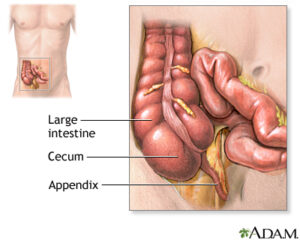Cancer of the Appendix
Types of Cancer of the Appendix
There are several types of appendix tumors, some of which are cancerous and some of which are not. The two main types of appendix cancer are called carcinoid tumors and carcinomas.
Carcinoid tumors
Carcinoid tumors are the most common appendix cancers, accounting for about half of those diagnosed. They are usually found at the tip of the appendix. Because they do not cause symptoms, these tumors are often detected after the appendix is removed. They are a type of gastrointestinal neuroendocrine tumor (NET).
Carcinomas
Appendiceal carcinomas include:
Mucinous adenocarcinoma: This is the next most common type of appendix cancer. They start in the appendix, but are most often discovered after they have metastasized to the peritoneum (the inner wall of the abdominal cavity).
Goblet cell carcinoids (also called adenocarcinoma tumors): These are less common tumors that, despite the name, are not carcinoid tumors or NETs. They behave and are treated similarly to mucinous adenocarcinoma.
Intestinal-type adenocarcinoma: These tumors are usually found near the fundus or base of the appendix. When these tumors cause symptoms, they often resemble symptoms of colon cancer.
Signet ring cell adenocarcinoma: This is a very rare but aggressive type of appendix cancer. They often cause appendicitis.
Many other precancerous tumors of the appendix may be found during an appendectomy. Most are treated by simply removing the organ, but some require follow-up, as they may have a small risk of recurrence.
One of these tumor types is appendiceal mucoceles, sacs or cysts in the wall of the appendix that are seen on a CT scan. This type of lesion is not cancerous, but cancer cannot be ruled out unless they are removed.
Cancer of the Appendix – Symptoms
Unless a tumor in the appendix causes appendicitis, you may not have noticeable symptoms until the cancer has advanced and spread to other organs or caused a blockage. Often, appendicitis is diagnosed incidentally when the organ is removed or when a patient has an ultrasound for another reason, and the radiologist notices a suspicious mass.
The main symptom of appendicitis – bloating or an increase in the size of the abdomen – could be a sign of many other diseases.
Other symptoms related to the organs to which the cancer has spread. These include:
- pelvic discomfort or vague abdominal discomfort, usually on the right side
- abdominal pain and/or a feeling of fullness
- hernias
- blockage or obstruction of the bowel
- inability to pass gas
- diarrhea
- ovarian masses
- shortness of breath
- redness or flushing around the face and neck
- loss of appetite
- nausea
- vomiting
Symptoms of appendicitis include:
- Acute, severe pain that starts in the center of the abdomen but moves down to the lower right side
- pain that worsens with coughing
- nausea and vomiting
- low fever
- diarrhea or hard stools
If the appendix ruptures, symptoms may subside for a while. However, they will return, along with other symptoms.
Diagnosis
Appendicitis is difficult to diagnose in its early stages because it has few symptoms. There are no reliable blood or urine tests to diagnose appendicitis.
Imaging tests:
- CT scan
- MRI scan
- PET scan
Colonoscopy. Occasionally, an endoscope can see a tumor growing from the appendix into the large intestine.
Biopsy: In this test, a small piece of tissue is removed from a suspicious area and sent to a laboratory to be examined for abnormal or cancerous cells.
Cancer of the Appendix – Treatment
Surgery
Surgery is the most common first step in treating localized appendicitis. Depending on the stage of your disease, your surgeon may perform one of the following procedures.
Appendectomy
If the tumor has not spread to other organs, an appendectomy – removal of the appendix – may be enough to remove the cancer.
Hemicolectomy
If the cancer is a carcinoid tumor and is larger than 2 cm, the part of the colon next to the appendix will need to be removed and reconnected to the rest of the colon.
A hemicolectomy may also be recommended for other types of appendix cancer.
Cytoreductive or lumpectomy surgery
If the appendix cancer is not carcinomatous and is found to be at a later stage (meaning it has spread), then cytoreductive or lumpectomy surgery is indicated. During this procedure, the tumor, surrounding fluid, if any, and any organs attached to the tumor, such as parts of the intestine, gallbladder, spleen, ovaries, uterus, and appendix, are removed.
Chemotherapy
Chemotherapy uses a drug or combination of drugs to target and kill cancer cells. If the cancer has spread beyond the appendix, chemotherapy is recommended, which is given in one of three ways:
Systemic chemotherapy is given intravenously (using an intravenous injection) or by mouth. It is usually given in cycles over a period of time and may be used before or after surgery to remove the tumor.
Regional chemotherapy, or intraperitoneal chemotherapy (IPC) in the case of appendix cancer, is a one-time treatment given directly into the abdomen during or shortly after surgery to remove the tumor. The two most common methods of giving IPC are early postoperative intraperitoneal chemotherapy (EPIC) and hyperthermic intraperitoneal chemotherapy (HIPEC).
Radiation therapy
Many types of cancer are treated with radiation therapy, although this is rarely done with appendix cancer.





